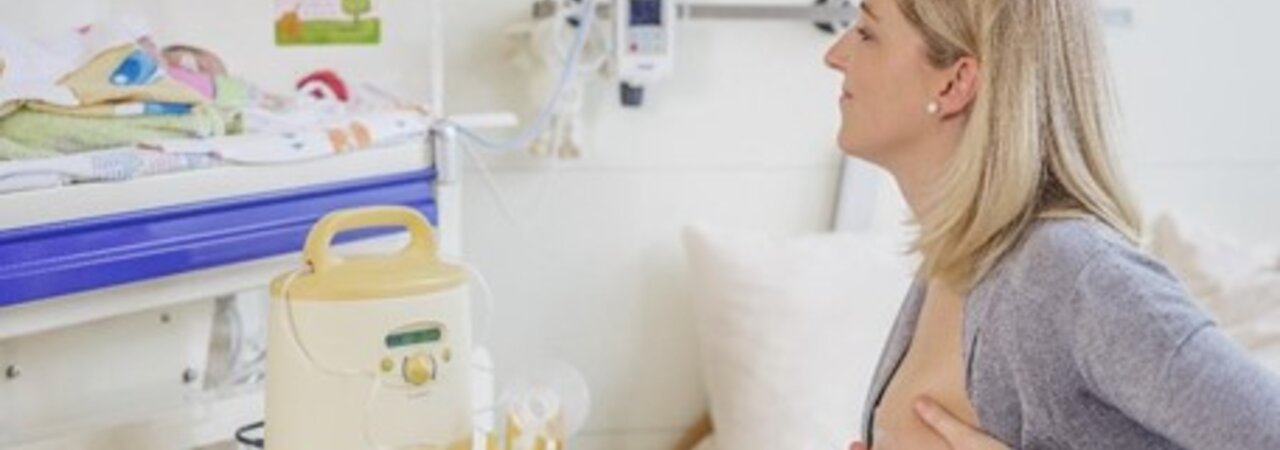You are currently viewing:
Medela - English
You can select an alternative Medela website in one of these countries:
- Products
- Articles
- Medela Family
- Services
- Lactation Professionals
Effective initiation
Time to read: 3 min.
When the infant is not able to breastfeed, stimulating the mother’s breast by frequent milk expression is an evidence-based intervention that helps the mother initiate and build sufficient milk volumes for the long term.

Expressing at least 8 or more times in 24 hours, inclusive of a nightime expression.
When the infant is not able to breastfeed, the mother needs to stimulate the breast and express milk frequently to initiate, build and maintain milk volumes.1
During the first days after birth, frequent breast stimulation through suckling or vacuum2,3 enhances hormone concentrations and supports the closure of the cellular junctions between the lactocytes and the transition into secretory activation by 72 hours (known as milk 'coming in').4,5
During the critical window of the first 14 days, when breast milk is removed frequently (8 or more times in 24 hours), the breast milk-making cells are programmed to initiate, build and establish milk supply, enabling mothers to achieve the required milk volumes for their infant’s long-term needs.4
Pumping regimes must mimic the pattern of a healthy breastfed term born infant and thus pumping sessions need to occur 8-12 times per 24 hours.6
Provide support to pump-dependent mothers following discharge home11
Collect data on frequent expression with a data collection tool
Review pumping logbooks and collect daily frequency of pumping data
Carry out monthly audits of the data to measure the average daily frequency of pumping during the first 14 days postpartum
Identify hospital practices where mothers may not achieve frequent expression
Identify contributing factors such as availability of home-use pumps, time etc that reduce pumping frequency
Communicate findings and recommendations regularly to all departments to improve and sustain best practice
1. Spatz DL et al. Pump early, pump often: A continuous quality improvement project. J Perinat Educ. 2015; 24(3):160–170.
2. Lussier MM et al. Daily breastmilk volume in mothers of very low birth weight neonates: a repeated-measures randomized trial of hand expression versus electric breast pump expression. Breastfeed Med. 2015; 10(6):312–317.
3. Meier PP et al. Supporting breastfeeding in the Neonatal Intensive Care Unit: Rush Mother's Milk Club as a case study of evidence-based care. Pediatr Clin North Am. 2013; 60(1):209–226.
4. Neville MC, Morton J. Physiology and endocrine changes underlying human lactogenesis II. J Nutr. 2001; 131(11):3005S-3008S.
5. Hoban R et al. Human Milk Biomarkers of Secretory Activation in Breast Pump-Dependent Mothers of Premature Infants. Breastfeeding Medicine. 2018; 13(5):352–360.
6. Spatz DL. Ten steps for promoting and protecting breastfeeding for vulnerable infants. J Perinat Neonatal Nurs. 2004; 18(4):385–396.
7. UNICEF, WHO. Protecting, promoting and supporting breastfeeding: The baby-friendly hospital initiative for small, sick and preterm newborns. Geneva, New York: WHO; UNICEF; 2020. 42 p.
8. Prime DK et al. Simultaneous breast expression in breastfeeding women is more efficacious than sequential breast expression. Breastfeed Med. 2012; 7(6):442–447.
9. Sakalidis VS et al. Breast shield design impacts milk removal dynamics during pumping: A randomised controlled non-inferiority trial. Acta Obstet Gynecol Scand. 2020; 99(11):1561-1567.
10. Takako H et al. Improving Human Milk and Breastfeeding Rates in a Perinatal Hospital in Japan: A Quality Improvement Project. Breastfeed Med. 2020; 15(8):538–545.
11. Bower K et al. "I Had One Job and That Was To Make Milk". J Hum Lact. 2017; 33(1):188–194.
Articles that may be of interest